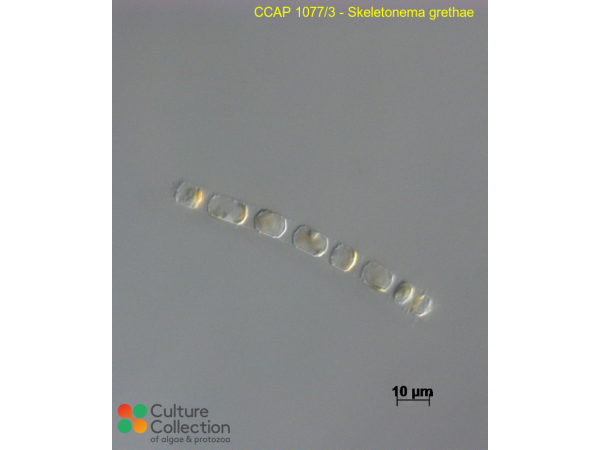References [ 22 ]
Davoren M, Ní Shúilleabháin S, O'Halloran J, Hartl MGJ, Sheehan D, O'Brien NM, Van Pelt FNAM & Mothersill C (2005) A test battery approach for the ecotoxicological evaluation of estuarine sediments. Ecotoxicology 14(7): 741-755.
Alverson AJ & Kolnick L (2005) Intragenomic nucleotide polymorphism among small subunit (18S) rDNA paralogs in the diatom genus Skeletonema (Bacillariophyta). Journal of Phycology 41: 1248-1257.
Sarno D, Kooistra WHCF, Medlin LK, Percopo I & Zingone A (2005) Diversity in the genus Skeletonema (Bacillariophyceae). II. An assessment of the taxonomy of S. costatum-like species with the description of four new species. Journal of Phycology 41: 151-176.
Day JG, Benson EE & Fleck RA (1999) In Vitro Culture and Conservation Of Microalgae: Applications For Environmental Research, Aquaculture & Biotechnology. In Vitro Cellular & Developmental Biology - Plant 35: 127-136.
Kaczmarska I, Beaton M, Benoit AC & Medlin LK (2005) Molecular phylogeny of selected members of the order Thalassiosirales (Bacillariophyta) and evolution of the Fultoportula. Journal of Phycology 42: 121-138.
Sarno D, Kooistra WHCF, Balzano S, Hargraves PE & Zingone A (2007) Diversity in the genus Skeletonema (Bacillariophyceae). III. Phylogenetic position and morphological variability of Skeletonema costatum and Skeletonema grevillei with the description of Skeletonema ardens sp. nov. Journal of Phycology 43: 156-170.
Moriceau B, Goutx M, Guigue C, Lee C, Armstrong R, Duflos M, Tamburini C, Charrière & Ragueneau O (2009) Si-C interactions during degradation of the diatom Skeletonema marinoi. Deep-Sea Research II 56: 1381-1395.
Hatton AD & Wilson ST (2007) Particulate dimethylsulphoxide and dimethylsulphoniopropionate in phytoplankton cultures and Scottish coastal waters. Aquatic Sciences - Research Across Boundaries 69: 330-340.
Simon N, Campbell L, Örnolfsdottir E, Groben R, Guillou L, Lange M & Medlin LK (2000) Oligonucleotide probes for the identification of three algal groups by dot blot and fluorescent whole-cell hybridization. Journal of Eukaryotic Microbiology 47(1): 76-84.
DOI: none
Tengs T, Dahlberg OJ, Shalchian-Tabrizi K, Klaveness D, Rudi K, Delwiche CF & Jakobsen KS (2000) Phylogenetic analyses indicate that the 19'hexanoyloxy-fucoxanthin-containing dinoflagellates have tertiary plastids of haptophyte origin. Molecular Biology and Evolution 17(5): 718-729.
DOI: none
Kooistra WHCF, Sarno D, Balzano S, Gu H, Andersen RA & Zingone A (2008) Global diversity and biogeography of Skeletonema species (Bacillariophyta). Protist 159: 177-193.
Kheder RB, Quéré C, Moal J & Robert R (2010) Effect of nutrition on Crassostrea gigas larval development and the evolution of physiological indices. Part B: Effects of temporary food deprivation. Aquaculture 308: 174-182.
Wilson ST (2007) The production of biogenic gases in the marine environment. A Thesis presented for the degree of Doctor of Philosophy at the Open University -: 319 pp.
DOI: none
Rico-Villa B, Le Coz JR, Mingant C & Robert R (2006) Influence of phytoplankton diet mixtures on microalgae consumption, larval development and settlement of the Pacific oyster Crassostrea gigas (Thunberg) Aquaculture 256: 377-388.
Medlin LK, Elwood HJ, Stickel S & Sogin ML (1991) Morphological and genetic variation within the diatom Skeletonema costatum (Bacillariophyta): Evidence for a new species, Skeletonema pseudocostatum. Journal of Phycology 27: 514-524.
DOI: none
Gonzalez-Araya R, Quillien V & Robert R (2013) The effects of eight single microalgal diets on sex-ratio and gonad development throughout European flat oyster (Ostrea edulis L.) conditioning. Aquaculture 400-401: 1-5.
Medlin LK & Kaczmarska I (2004) Evolution of the diatoms: V. Morphological and cytological support for the major clades and a taxonomic revision. Phycologia 43: 245-270.
Erga SR, Lie GC, Aarø LH, Frette Ø & Hamre B (2014) Migratory behaviour of Skeletonema grethae (Bacillariophyceae) in stratified waters. Diatom Research 30: 13-25.
Po BHK, Ho KL, Lam MHW, Giesy JP & Chiu JMY (2017) Uptake and biotransformation of 2,2′,4,4′-tetrabromodiphenyl ether (BDE-47) in four marine microalgae species. Scientific Reports 7: 44263.
Yamada M, Otsubo M, Tsutsumi Y, Mizota C, Nakamura Y, Takahashi K & Iwataki M (2017) Utility of mitochondrial-encoded cytochrome c oxidase I gene for phylogenetic analysis and species identification of the planktonic diatom genus Skeletonema Phycological Research -: -.
González-Araya R & Robert R (2018) Larval development and fatty acid composition of Ostrea edulis (L.) fed four different single diets from conditioning to pre‐settlement Aquaculture Research 49: 1768-1781.
Garvetto A, Badis Y, Perrineau M, Rad Menéndez C, Bresnan E & Gachon CMM (2019) Chytrid infecting the bloom-forming marine diatom Skeletonema sp.: Morphology, phylogeny and distribution of a novel species within the Rhizophydiales Fungal Biology 123: 471-480.




